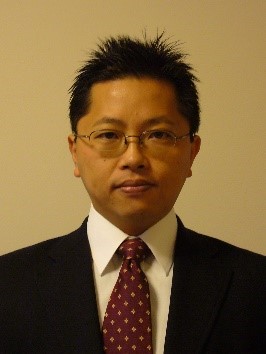Prof. Takeyoshi Kato

Biographical Information
Takeyoshi Kato was born in Nagoya, Japan in 1968. He received the B.S., M.S., and Ph.D. degrees all in Electrical Engineering from Nagoya University, Japan in 1991, 1993, and 1996, respectively. He became an assistant professor of Center for Integrated Research in Science and Engineering in 1996, an assistant professor in 2000 and an associate professor in 2005 of the Department of Electrical Engineering and Computer Science, and a professor of Institute of Materials and Systems for Sustainability (former Ecotopia Science Institute) in 2015, Nagoya University. From Oct/2001 to Sep/2002, he was a researcher at International Institute for Applied Systems Analysis (IIASA) in Austria.
His research interests include modeling/forecasting of electricity demand/renewable power output, control and planning of electric power system, integration of renewable energy with urban design, etc. Dr. Kato is a member of IEEE, IEE of Japan, Japan Society of Energy and Resources, Japan Solar Energy Society.
He will give a talk on “Solar Power Forecasting as a Key Technology in Smart Grid”.
Abstract
This talk presents two topics related to a microgrid, i.e. a forecasting of irradiance and an islanding operation in emergency situation.
An accurate and reliable forecasting method of renewable power output is one of the key technologies for a stable operation of microgrid with high
penetration renewable power generation in both grid-connected mode and islanded mode. Various resources and methods for irradiance forecasting are
available according to the required time-horizon and needs in microgrid operations. Numerical weather prediction (NWP) models are the most accurate
and reliable approach for a day-ahead forecasting utilized for a power supply-demand scheduling for each hour of the next day. Satellite images and
all-sky images are useful for the forecasting of short-time horizon, in which PV power output is forecasted based on cloud motion vectors calculated
by using successive images. Because the irradiance forecasting is a cutting edge research area, it needs further improvement on the accuracy and reliability.
At the same time, an operation scheme of microgrid should be improved in consideration of the characteristics of various forecasting methods.
Prof. Kaigui Xie

Biographical Information
Kaigui Xie (M’10–SM’13) was born in 1972 in Sichuan, P.R. China. He received the Ph.D. degree in Power System and Its Automation at Chongqing University, Chongqing, China, in 2001. Currently, he is a full professor in the School of Electrical Engineering, Chongqing University, China. His main research interests focus on areas of power system reliability, planning and analysis. He is an editor of the IEEE Transactions on Power Systems and a member of editorial board of Electric Power Components and Systems. He is the author and coauthor of over 200 academic papers and five books.
He will give a talk on “Reliability Evaluation of Microgrids Considering Operation Modes”.
Abstract
This talk presents Individual components of a power system have different impacts on the overall system unreliability.
It would be very useful to determine the contribution of each system component to the system unreliability, and recognize the weak
parts within the system. This would provide a useful tool to direct remedial measures for improving the system reliability in power system
operation and planning processes. This presentation presents unreliability tracing models and algorithms for power systems based on
two unreliability tracing principles, i.e. the failure component sharing principle and the proportional sharing principle. The technique
is illustrated by application to the RBTS and the IEEE-RTS generation systems and bulk power systems, as well as ultra high voltage DC
transmission systems. The case studies indicate that the discussed technique can be used to recognize the weak parts of a BPS.
Prof. Ying-Yi Hong

Biographical Information
Ying-Yi Hong received his B.S.E.E and M.S.E.E. degrees from the Chung Yuan Christian University (CYCU) and the National Cheng Kung University, Taiwan, in 1984 and 1986, respectively. Sponsored by the Ministry of Education of R.O.C., he conducted research in the Department of E.E. at the University of Washington, Seattle, from August 1989 to August 1990. He received his Ph.D. degree from the Institute of E.E. in December 1990 from the National Tsing-Hua University, Taiwan. Professor Hong’s area of interest includes power system planning and operation, microgrid control and operation, power quality, and power market to which the artificial intelligence, soft computing and optimization methods are applied. Since 1991, Professor Hong has chaired/cochaired more than 90 projects. Professor Hong received the 2003 and 2006 Outstanding Research Awards at the CYCU. He also received the Outstanding Electrical Engineering Professor Award from the Chinese Institute of Electrical Engineering in 2006. Professor Hong is an IEEE senior member and an IET Fellow. He was the Chair of the IEEE Power Engineering Society Taipei Chapter in 2001 and 2002 and is the Vice Chair of IEEE Taipei Section in 2013-2014. Up to now, he publishes 81 SCI journal papers, and 180 conference papers. From 2006-2012, he was the Dean of College of Electrical Engineering and Computer Science at CYCU. At present, he is awarded as a Distinguished Professor and serves as a Secretary General at CYCU.
He will give a talk on “Taguchi Method-based Probabilistic Load Flow Studies Considering Uncertain Renewables and Loads”.
Abstract
This talk presents Load flow studies are crucial in investigations of operation and planning problems in the power systems.
Traditional methods for determining load flow are based on deterministic approaches. However, the parameters of a power system
(such as load and renewable power generation) may be uncertain. An exact probabilistic load flow (PLF) study requires a long CPU time due
to many convolution computations involving probability density functions. A simple but accurate method is therefore needed to study
the PLF in the modern power system. This paper proposes a novel PLF method that is based on Taguchi’s orthogonal arrays.
The proposed method utilizes a few deterministic load flow solutions that are obtained using Taguchi’s method to estimate the means
and standard deviations of bus voltages, phase angles, line flows, and other metrics. A load flow calculation corresponds to
an experiment in Taguchi’s method. An optimal experiment is also specified by considering the largest deviation from the nominal load flow solution.
A 25-bus standalone power system and a modified IEEE 118-bus system in which wind-turbine generators generate uncertain power are tested.
The simulation results show that the proposed method not only requires fewer deterministic load flow solutions to perform PLF analysis than
the traditional point-estimate method but also yields accurate means and standard deviations of bus voltages and line flows.
Prof. Sekyung Han

Biographical Information
Sekyung Han received received the B.S, M.S and Ph.D. degrees from Hanyang University, Korea, in 2002, Seoul National University, Korea, in 2007 and The University of Tokyo, Japan, in 2012 respectively. Now, he is professor of Smart Energy Network Lab (SENL), a Power System Laboratory, which forms part of the Department of Electrical Engineering in Kyungpook National University, Korea. His laboratory is renowned expert in Electric Vehicle and battery design. He has chaired/co-chaired more than 7 research projects. Professor Han published 12 SCI journal papers, 16 international conference papers, 2 academic books, and registered 4 patents.
He will give a talk on “New short term reliability indices considering the feedback control constraints”.
Abstract
This talk presents Due to the economic growth and the increase in populations, various problems such as energy resource depletion has become a global concern.
In order to achieve stable energy supply whiles reducing carbon dioxide emission, it is necessary to inject a large amount of renewable energy source in power production.
The renewable energy, such as wind power, photovoltaic, hydrogen energy, geothermal energy, and biomass are inexhaustible and CO2-free energy resource unlike fossil fuels.
The output of renewable energy, especially wind turbine, fluctuates according to the environmental conditions such as wind velocity, solar insolation.
With the introduction of large amount of renewable energy, the power fluctuation can cause grievous instability on the grid.
Generally, stability of grid is estimated by using reliability index. Existing reliability indices for power systems provide measures of long-term stability;
and is not effective for renewable energy because of its intermittent output fluctuations. In order to evaluate the influence of renewable energy on electrical power quality,
new reliability index should be made and adopted. In this work, we propose a new reliability criterion that estimates the probability of a loss of load occurring,
thus indicating the short-term stability of the grid frequency. In the formulation, Load, Wind power, and battery model power are represented as random processes,
and conventional generators are incorporated in a deterministic manner. Using the equilibrium of demand and supply and the physical constraints of automatic
generation control (AGC), a model was developed, from which the probability of successful frequency deviation distribution was obtained. The contrived probability,
referred to as Frequency Reliability Distribution Function (FRDF), is employed as a metric in the short-term reliability criterion. An impulse response was generated
from a MW impulse input into a general power model. A frequency fluctuation was estimated by a convolution of the impulse response, grid input data and the fluctuation
of the grid. The frequency fluctuation contributions of each of the energy sources committed was investigated and accounted for as well. The developed metric was applied
in several case studies. Finally, FRDF was calculated for the IEEE reliability test system and compared with conventional reliability indices.












